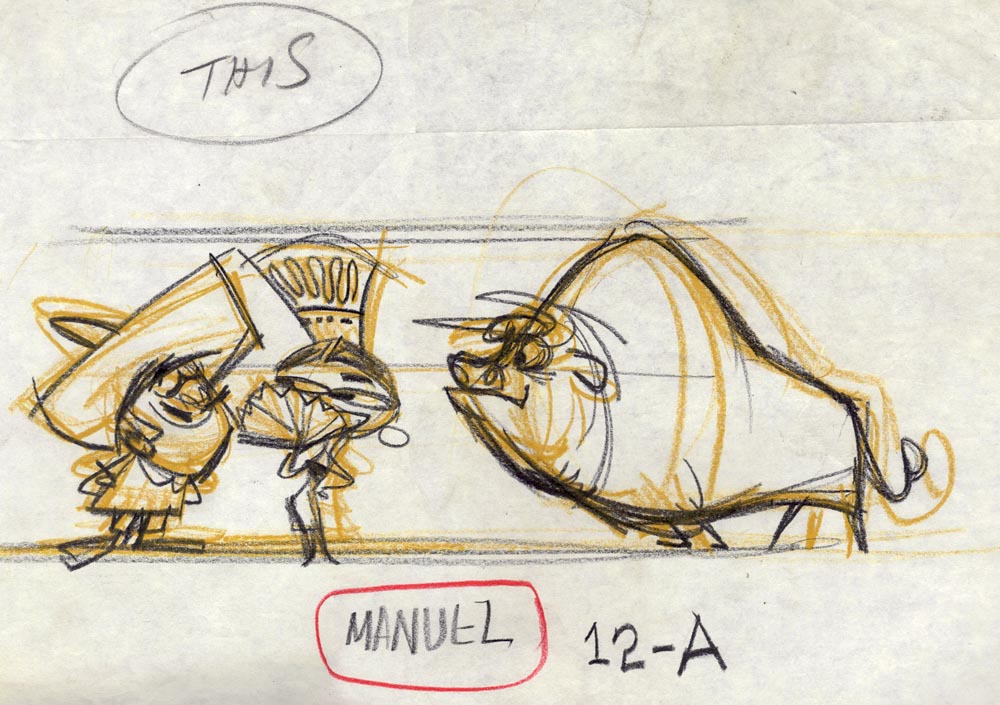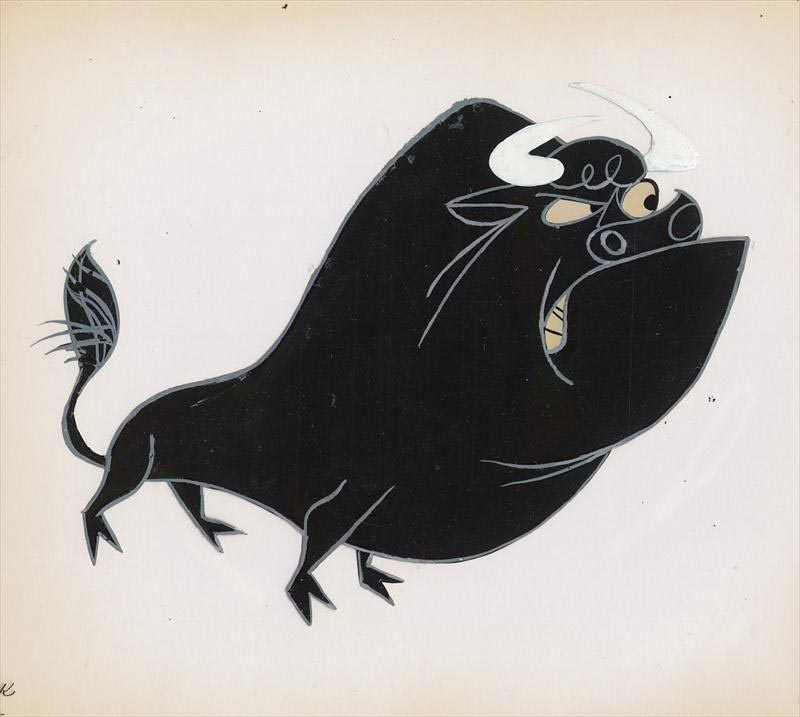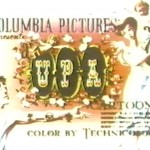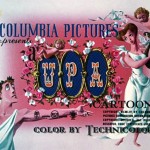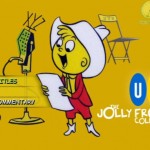The former Disney animator speaks about the challenges of creating an international co-production spanning more than a half-dozen countries, numerous visual styles, and almost a decade of production time.
Add a CommentViewing: Blog Posts Tagged with: UPA, Most Recent at Top [Help]
Results 1 - 19 of 19
Blog: Cartoon Brew (Login to Add to MyJacketFlap)
JacketFlap tags: Edgar Allen Poe, Guillermo del Toro, Christopher Lee, The Tell-Tale Heart, UPA, Bela Lugosi, Ted Parmelee, Roger Corman, Raúl GarcÃa, Extraordinary Tales, Cedric Gervais, Fabien Renelli, Interviews, Add a tag
Blog: Cartoon Brew (Login to Add to MyJacketFlap)
JacketFlap tags: Saul Steinberg, Comics, Fine Art, Terry Gilliam, UPA, Max Ernst, United Productions of America, Ad Reinhardt, David Malki!, David Zwirner Gallery, The Brotherhood of Man, Add a tag
Ad Reinhardt (1913-1967) was an artist’s artist, renowned among critics and curators, but hard for the general public to warm up to. His most famous fine art works are his Black Paintings, from the 1960s, which at first glance appear to be solid black, but on closer inspection turn out to be blocks of black and almost-black shades. Important, but challenging.
Add a CommentBlog: Cartoon Brew (Login to Add to MyJacketFlap)
JacketFlap tags: Cartoon Modern, UPA, Van Eaton Galleries, Tom Oreb, Victor Haboush, Bill Perez, Dick Tracy Show, Mike Van Eaton, Add a tag
A year or two ago, when I visiting Van Eaton Galleries in Sherman Oaks, the gallery’s proprietor, Mike van Eaton, showed me one of his then-recent acquisitions: a collection of drawings from the estate of animation veteran Bill Perez.
Throughout his career, Perez had kept a morgue file of animation character designs drawn by other artists. Most of these were random drawings that he picked up around the places he worked—quick sketches, discarded character model drawings, rough designs, and other ephemera that would have been lost if not for his collection. Many of the pages had multiple drawings pasted up of a particular subject, like old ladies or cats. There were few recognizable cartoon characters, but the collection was excellent reference for anyone who had to draw in a vintage TV style.
Mike generously allowed me to pick out a drawing of my choosing, and I chose this bull:
I didn’t realize what it was until a few months later when I was looking at another online auction site and saw this color model cel:
Of course, Manuel was Go-Go Gomez from UPA’s Dick Tracy Show (1961). Why I didn’t recognize this at the time is another question, but quickly flipping through hundreds of pages of similar looking artwork can fry your perception abilities. The only thing I knew is that I really liked the grouping of characters. What’s funny is that I had also unwittingly gravitated to a drawing that is almost certainly by my favorite designer of the Cartoon Modern period, Tom Oreb.
One of the last significant jobs of Oreb’s tragically short career was doing character models on the Dick Tracy series, a job he got thanks to his friend Victor Haboush, who was the show’s art director. Oreb commonly used colored pencils during this period, as he does in the underdrawing, but what really distinguishes it as his work is a flawless ability to boil down graphic concepts into the most basic yet dynamic forms. Even amongst the hundreds of other character designs in the Perez collection, this drawing popped out.
I don’t know if Mike van Eaton still has anything from the Bill Perez collection, but next time you’re there, be sure and ask him about it. You may find an affordable drawing or two in there that inspires you like this one inspired me.
Add a CommentBlog: Cartoon Brew (Login to Add to MyJacketFlap)
JacketFlap tags: Events, UPA, Adam Abraham, Add a tag

Animation historian Adam Abraham (author of When Magoo Flew: The Rise and Fall of Animation Studio UPA) will be doing a UPA talk and book signing at the New York Public Library’s Lincoln Center branch on Thursday December 6th at 6pm.
The format will be an illustrated lecture on the history of the UPA studio, with a screening of a handful of Columbia shorts (digital projection) and some rare behind-the-scenes footage (including the 50s documentary A Princess for Magoo).
This program is part of a Meet The Scholar series at the New York Public Library for the Performing Arts, Dorothy and Lewis B. Cullman Center, located at 40 Lincoln Center Plaza. Admission is free. For more information, please check the library’s website.
Add a CommentBlog: Cartoon Brew (Login to Add to MyJacketFlap)
JacketFlap tags: Advertising, Cartoon Modern, UPA, Roy Morita, United Productions of America, Add a tag
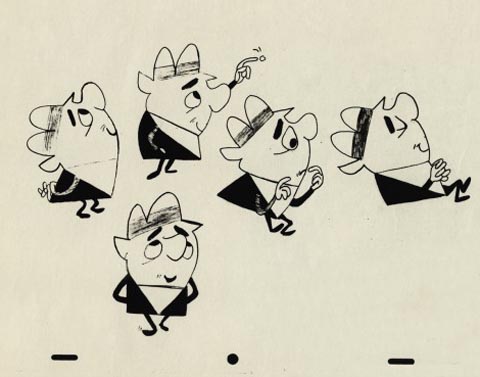
In the six years since the publication of my book Cartoon Modern: Style and Design in 1950s Animation, a lot of new artwork and films from the mid-century era have surfaced. The flow of material isn’t slowing down either. Animation director Michael Sporn recently came into possession of a trove of layouts and model sheets from 1950s United Productions of America (UPA) commercials. He’s generously shared them HERE and HERE.
Among the stash are a few drawings from an Aqua Velva Ice Blue aftershave lotion spot, which can be seen in this newly uncovered collection of UPA commercials:
These commercials are rarer than they might appear. Of the hundreds of commercials that UPA produced during the 1950s, I’ve managed to see just a few dozen over the years. UPA’s advertising work has proven more difficult to track down than some of the other major animated commercial producers of the era like Playhouse Pictures and Ray Patin Productions.
The same user on YouTube also posted this UPA commercial for Tang, which I believe was designed by Roy Morita.
Cartoon Brew |
Permalink |
No comment |
Post tags: Roy Morita, United Productions of America, UPA
Blog: Cartoon Brew (Login to Add to MyJacketFlap)
JacketFlap tags: UPA, Classic, Educational, Add a tag
The complete output of animation produced by UPA may never be definitively collected, as they produced a large quantity of material for the Army and the Navy; commercial, educational and industrial films for various clients; and interstitial bits and pieces – many of which are unaccounted for and some still undocumented.
I’m happy to report that we can cross this one off the “endangered species” list. Earlier this year The National Archives and Records Administration (NARA) painstakingly cleaned and digitally restored this rarely seen UPA Navy re-enlistment film from 1949. The restored film made its debut last month at the International Federation of Film Archives (FIAF) conference in Beijing, China.
The Sailor and the Seagull is a fascinating little film. The lead character, Sailor “MacGinty”, is a cross between the Navy’s Mr. Hook and UPA’s future character Pete Hothead. He is voiced by John T. Smith. Daws Butler is the Seagull, an classic old-school wise guy. It’s a pretty traditional looking picture until about 3:20 when an Arabian Nights fantasy sequence (predating the Magoo feature by ten years) turns it briefly into a stylized feast of scantily clad ladies and drunken debauchery!
There are no production credits, but I think its safe to assume that the direction is by John Hubley, the girl animation is by Pat Matthews and the music composed by Del Castillo. I welcome educated guesses as to who might have animated what – or any corrections to the above.
(Thanks, Florian Schmidlechner)
Cartoon Brew |
Permalink |
No comment |
Post tags: UPA
Blog: Cartoon Brew (Login to Add to MyJacketFlap)
JacketFlap tags: Classic, DVD, UPA, Jolly Frolics, Add a tag
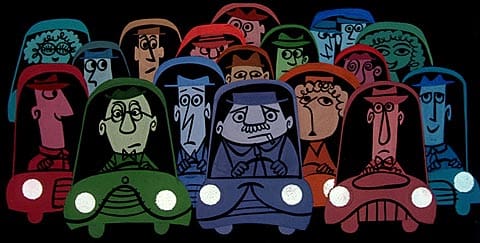
I’ve got two copies to give away of TCM’s 3-dvd UPA Jolly Frolics set. It’s loaded with visual delights guaranteed to inspire any fan of the “cartoon modern” aesthetic. Simpy leave a comment—say anything you wish—and make sure to include a real email address so I can contact you if you win. (Your email remains hidden and will not be used for any purpose other than to contact the winners.)
RULES: Contest will be closed at Saturday midnight (Eastern time). If you’ve won anything recently from us, you can’t win again. One entry per person. Multiple entries will automatically disqualify you.
Cartoon Brew |
Permalink |
101 comments |
Post tags: Jolly Frolics, UPA
Blog: Cartoon Brew (Login to Add to MyJacketFlap)
JacketFlap tags: UPA, Bobe Cannon, Shorts, Classic, DVD, Cartoon Modern, Add a tag

I watched all the UPA theatrical shorts back when I was writing Cartoon Modern, but seeing them restored on TCM’s new 3-DVD “Jolly Frolics” set has been an eye-opening experience. If there was ever any doubt about how progressive the studio was graphically, this set will dispel such notions. Immediately after UPA, the floodgates of animation design opened—by the mid-1950s, all varieties of graphic styles were being explored in TV advertising and industrial films, and soon after, European animation studios like Zagreb Film were out-UPAing UPA. The studio’s dominance lasted but only a short period, but UPA’s influence was lasting. It played a key role in pushing animation out of its cocoon, thus allowing it to evolve into the rich and diverse art form that it is today.
The director whose reputation will benefit most from this collection is Robert ‘Bobe’ Cannon. While his stories tend to be formulaic and thematically repetitive, often times it seemed like he was the only director at UPA who knew how to put together a coherent film. (A good deal of that credit also belongs to his close collaborator T. Hee, who wrote most of Cannon’s films.)
More than the stories though, it’s the way that Cannon animated characters, which looks even more refreshing today in light of all the generic Flash and After Effects animation. In Cannon’s work, the way a character moves is never separate from its design. Discovering a visually inventive way to animate a character from point A to point B is Cannon’s greatest strength. The two most famous films in the Cannon canon are Gerald McBoing Boing and Madeline, but his later efforts, especially Fudget’s Budget, Christopher Crumpet’s Playmate and The Jaywalker—all looking better than ever on this set—display remarkable confidence as a director.
Below is some random visual eye candy from the “Jolly Frolics” shorts. We’ll be giving away a couple copies of the set this weekend so check back.
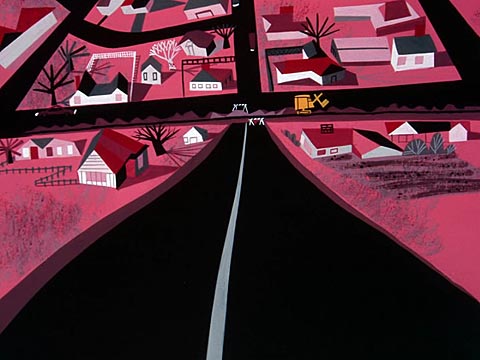
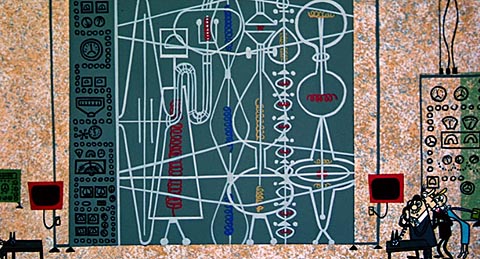
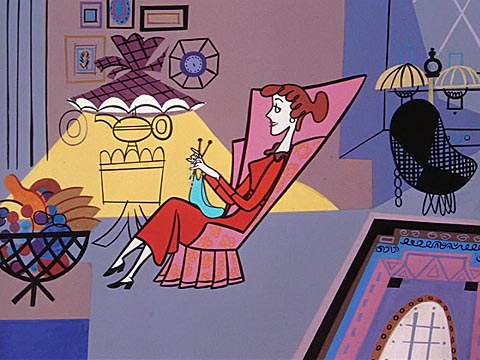
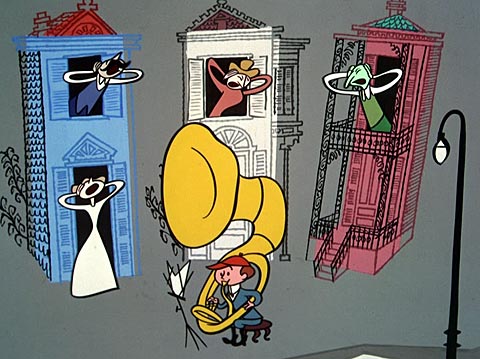
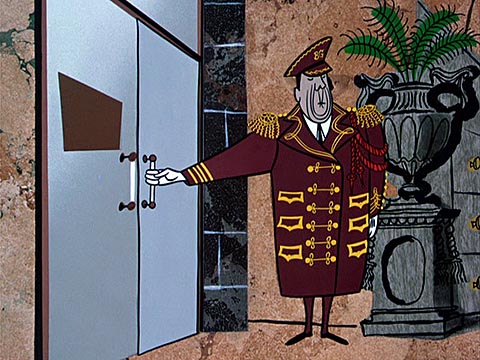

Blog: Cartoon Brew (Login to Add to MyJacketFlap)
JacketFlap tags: Events, UPA, Add a tag
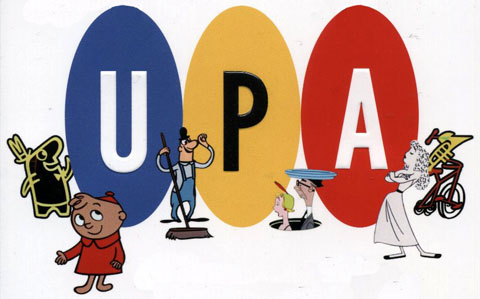
To celebrate the publication of Adam Abraham’s essential new UPA history, When Magoo Flew and the just-released TCM/Sony DVD set, UPA: The Jolly Frolics Collection
, the Los Angeles County Museum of Art (LACMA) will be presenting a mega-celebration of the UPA animation studio this Friday, March 30th beginning at 7:30pm.I will be introducing two programs of animated films – the first at 7:30pm which will feature ten newly restored 35mm prints of UPA classics including Rooty Toot Toot, Magoo’s Express, and Fudget’s Budget. Adam Abraham will sign copies of his newly released book at 8:45pm and at 9:15pm a second program of 35mm Hollywood cartoons that were influenced by UPA will screen. This second screening will include Disney’s Toot Whistle Plunk and Boom, Terry toons’ Flebus (both of these in CinemaScope), Tex Avery’s SHHH-H-H-H and Gene Deitch’s Topsy TV (also in ‘Scope). Several UPA veterans will attend the show – and we hope you will too. Click here for information and tickets.
CONTEST: Courtesy of LACMA, I have two gift-pack prizes for two lucky Cartoon Brew readers in the Los Angeles area. The first two people to answer the UPA trivia question below will win a pair of tickets to Friday’s event and a copy of Adam Abraham’s book When Magoo Flew (both prizes will be waiting for you at the museum’s box office). Do not enter the contest if you cannot attend the event in Los Angeles. The Contest is now CLOSED:
Who was the voice of Mr. Magoo?
We have our winners!
Cartoon Brew |
Permalink |
4 comments |
Post tags: UPA
Blog: Cartoon Brew (Login to Add to MyJacketFlap)
JacketFlap tags: Classic, DVD, UPA, Add a tag
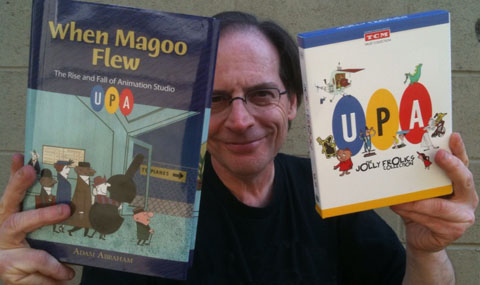
They’re out… and as Tony the Tiger would say: “They’re Grrrr-reat!”
I will go out on limb right now and declare TCM’s UPA: The Jolly Frolics Collection the DVD of the year. This thing is loaded (full disclosure: I was involved in the process). It is beautifully and cleverly packaged and contains a 16-page booklet with brief essay by UPA historian Adam Abraham, capsule biographies of key UPA personnel, a UPA chronology chart with key events and a release chart timelime, plot synopsis and more…
The three discs themselves are packed with incredible restorations of 38 UPA cartoons. These restorations are so good, they will force many to reevaluate their opinions of these films. Cartoons I’d long dismissed as inferior – The Oompahs, The Miner’s Daughter, Baby Boogie and others – are suddenly vibrant, colorful and clear; what the filmmakers intended, and a lot better than I’d thought. Compare the frame grab of from my personal bootleg video copy of The Man On The Flying Trapeze (thumbnail below left to enlarge) with the restoration (below, center) to give you a small idea of the difference. Even if you have no interest in UPA, I think you’ll come to understand their importance through this set.
Sony went to great lengths to restore the cartoons on this collection – restoring original front and end titles (like the Fox & Crow title (below) from their first theatrical, Robin Hoodlum). Alas not every title could be restored (though most are), but what is here is from the original negs – and they are a pleasure to see anew.
I’m not even mentioning the bonus materials (Concept art, model sheets, storyboards, color styling sketches, background, publicity stills, movie poster galleries – and more, including audio commentaries and a Leonard Maltin introduction). If you’ve ordered it, it’s on the way. If you haven’t – what are you waiting for?
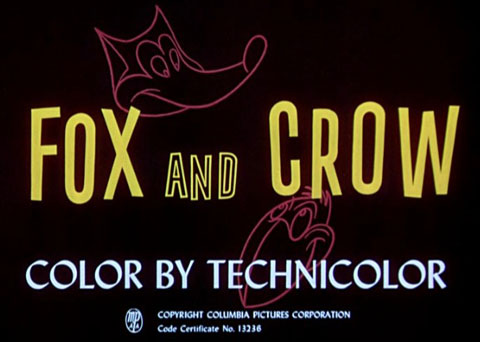
Adam Abraham’s important new history of UPA – When Magoo Flew – has also just been published by Wesleyan University Press. I’m not going to review it right now – but I will be giving a copy or two away in a pop-quiz contest sometime on Thursday. Adam will be in L.A. a week from Friday to sign copies of the book at LACMA, at the UPA tribute I’m hosting on March 30th. (Tickets available now – hint, hint!).
Adam has
Add a CommentBlog: Cartoon Brew (Login to Add to MyJacketFlap)
JacketFlap tags: Events, UPA, Add a tag
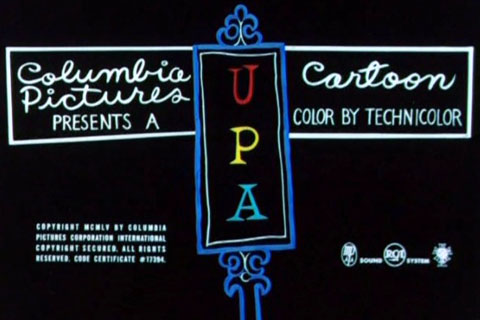
As far as I’m concerned, their can’t be enough praise and recognition for United Productions of America (UPA). They may be long gone and (by some) long forgotten, but their influence is still felt in every nook and cranny of the animation craft.
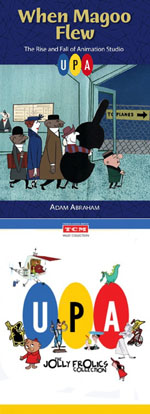 On March 30th in Los Angeles, I will be curating a special selection of UPA cartoons at LACMA (The Los Angeles County Museum of Art) in conjunction with their ongoing exhibit, California Design. We will be celebrating the studio with ten newly restored 35mm prints courtesy of Columbia Pictures/Sony (titles will include ROBIN HOODLUM, ROOTY TOOT TOOT, THE JAYWALKER, GERALD McBOING BOING and others). Not only will I introduce the show, but my colleague Adam Abraham will be on hand to sign copies of his hot-off-the-press UPA history book, When Magoo Flew. We will also have copies of TCM’s new DVD collection, UPA Jolly Frolics on hand for purchase. The event, titled Madcap Modernism: Mid-Century Cartoons from UPA and Beyond will start at 7:30pm on Friday, March 30, 2012, in LACMA’s Bing Theater. General admission is $10. ($7 for LACMA members, seniors (62+), and students with valid ID; $5 LACMA Film Club members). Advance tickets are now on sale: call 323 857-6010 or purchase online. For more information visit the LACMA website. Several other surprises are being planned. Mark your calendar now – don’t miss this special cartoon event.
On March 30th in Los Angeles, I will be curating a special selection of UPA cartoons at LACMA (The Los Angeles County Museum of Art) in conjunction with their ongoing exhibit, California Design. We will be celebrating the studio with ten newly restored 35mm prints courtesy of Columbia Pictures/Sony (titles will include ROBIN HOODLUM, ROOTY TOOT TOOT, THE JAYWALKER, GERALD McBOING BOING and others). Not only will I introduce the show, but my colleague Adam Abraham will be on hand to sign copies of his hot-off-the-press UPA history book, When Magoo Flew. We will also have copies of TCM’s new DVD collection, UPA Jolly Frolics on hand for purchase. The event, titled Madcap Modernism: Mid-Century Cartoons from UPA and Beyond will start at 7:30pm on Friday, March 30, 2012, in LACMA’s Bing Theater. General admission is $10. ($7 for LACMA members, seniors (62+), and students with valid ID; $5 LACMA Film Club members). Advance tickets are now on sale: call 323 857-6010 or purchase online. For more information visit the LACMA website. Several other surprises are being planned. Mark your calendar now – don’t miss this special cartoon event.
Cartoon Brew |
Permalink |
No comment |
Post tags: UPA
Blog: Cartoon Brew (Login to Add to MyJacketFlap)
JacketFlap tags: Animators, Classic, Cartoon Modern, UPA, T. Hee, Charles Eames, Eames Office, Ray Eames, Add a tag
I was digging around for some UPA photos the other day when I stumbled onto this photo that I’d labeled “Tee Hee and visitors.” Tee Hee is, of course, the gentleman on the right—a sequence director on Pinocchio and the “Dance of the Hours” segment in Fantasia, before moving over to UPA where he worked with director Bobe Cannon on shorts like Gerald McBoing Boing, Fudget’s Budget and The Jaywalker. When I looked at this photo again though, I thought, “Wait a second…these aren’t any ordinary visitors…they’re the legendary husband-and-wife design team of Charles and Ray Eames!” At least I’m fairly certain they are. If anybody can confirm this, please do.
The cross-pollination between creative disciplines was an essential ingredient of the “cartoon modern” era. I wrote a little bit about Charles and Ray Eames and their relationship to animation on the Cartoon Modern blog. The story goes that Charles Eames was so impressed after he visited the UPA studio that he bought stock in the company. The Eames later created some animated projects and hired animation artists like John Whitney, Dolores Cannata, Ed Levitt and Chris Jenkyns. Here’s a film they produced in 1958 called The Expanding Airport:
Cartoon Brew: Leading the Animation Conversation |
Permalink |
No comment |
Post tags: Charles Eames, Eames Office, Ray Eames, T. Hee, UPA
Blog: Cartoon Brew (Login to Add to MyJacketFlap)
JacketFlap tags: UPA, Adam Abraham, Books, Shorts, Classic, Add a tag
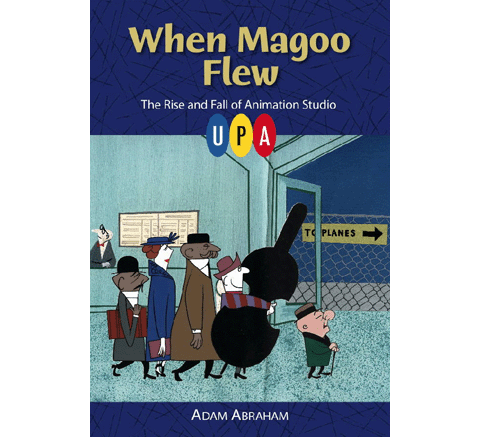
If you are planning to buy the two sets of UPA cartoons that Jerry posted about, you would do well to also pick up the forthcoming history of the UPA studio, When Magoo Flew: The Rise and Fall of Animation Studio UPA by Adam Abraham. As far as I know, the book and the DVDs weren’t planned together, but the stars are aligned, and one of the most important yet neglected animation studios of all time is ripe for rediscovery in 2012.
I’ve already read Adam’s book and I’m happy to report that he gets it absolutely right. The research is impeccable, the writing solid, the story fascinating. Though the book includes over 70 illustrations, it’s more narrative history than coffeetable art book, but that’s hardly an issue anymore thanks to the two companion DVD sets that contain UPA’s entire theatrical short output. The 324-page When Magoo Flew will be released by Wesleyan University Press next March. Place your pre-order on Amazon for a mere $20.
Cartoon Brew: Leading the Animation Conversation |
Permalink |
No comment |
Post tags: Adam Abraham, UPA
Blog: Cartoon Brew (Login to Add to MyJacketFlap)
JacketFlap tags: Events, UPA, Add a tag
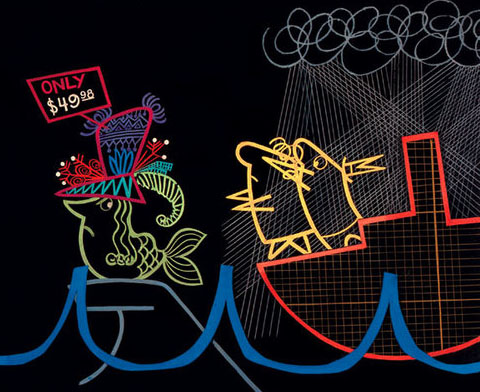
Tonight at 8pm is that tribute to UPA I told you about last week. Its the latest subject of my Animation Tuesday screenings, held each month at the former Silent Movie Theatre on Fairfax (near Melrose Ave). Tonight we will be running gorgeous 35mm prints on the big screen direct from the studio vault (Thank you, Sony) of some the UPA’s true classics and oddities — including their acclaimed adaptation Edgar Allen Poe’s The Tell Tale Heart, Oscar winner When Magoo Flew (in wide screen CinemaScope), and rarely shown The Jaywalker, Willie The Kid and Fudget’s Budget (pictured above) – and more (ever seen a Dick Tracy in 35mm?). Plus: a special surprise guest voice actress in-person (hint: she narrates one of UPA’s greatest shorts). Info and tickets: click here.
Cartoon Brew: Leading the Animation Conversation |
Permalink |
No comment |
Post tags: UPA
Blog: Cartoon Brew (Login to Add to MyJacketFlap)
JacketFlap tags: UPA, Events, Add a tag

Creators of Mr. Magoo and Gerald McBoing Boing, United Productions of America (UPA) was the most significant animation studio of the 1950s. Ushering in a whole new way of making cartoons, combining modern art with slapstick comedy, UPA challenged the way Disney made toons and dominated the Academy Awards during that decade. There’s no doubt of their inspiration on international and independent animators for decades to come.
Charles Solomon (who did a great job hosting the Mary Blair tribute last night at the Academy) recorded an audio editorial championing UPA that will run on L.A.’s public radio station KPCC (90.3 FM), Off Ramp, Saturday at noon and Sunday at 7pm. Solomon points out that a current local art show cooperative – Pacific Standard Time, which celebrates southern California’s contributions to pop culture – omits the UPA studio’s significant influence on art and animation. KPCC has just posted his piece online, in advance of its broadcast: Download or listen to stream here.
Meanwhile, I will be doing my part by mounting a tribute to UPA at my next Animation Tuesday screening, on Tuesday November 1st at 8pm. I will be introducing rare 35mm prints of the studio’s undeniable classics on the big screen — including their acclaimed adaptation Edgar Allen Poe’s The Tell Tale Heart, Oscar winner When Magoo Flew (in wide screen CinemaScope), and rarely shown The Jaywalker, Willie The Kid and Fudget’s Budget and more — along with a selection of rare commercials, industrial films and TV films not seen in public for over 50 years. More info and tickets: click here.
Cartoon Brew: Leading the Animation Conversation |
Permalink |
No comment |
Post tags: UPA
Blog: Cartoon Brew (Login to Add to MyJacketFlap)
JacketFlap tags: Lee Orgel, TV, UPA, Add a tag
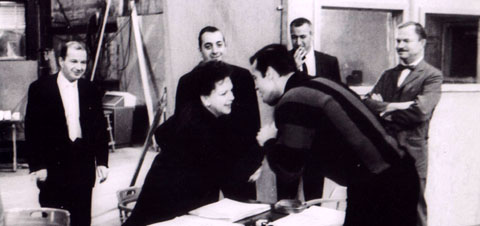
In the Gay Purr-ee production photo above is (left to right): Lee Orgel, Judy Garland, Henry G. Saperstein, Robert Goulet, Abe Levitow and Chuck Jones. Who was Lee Orgel you ask? Let Darrell Van Citters tell you.
Animator Van Citters is expanding on his great book about the history ofMr. Magoo’s Christmas Carol with an incredible blog containing additional information on the artists, writers, director and producers of this groundbreaking 1962 TV special.
Perhaps the most unsung of behind-the-scenes latter-day UPA personnel was Orgel – a talented, perhaps visionary, producer who had a successful career in 60s animation, as well as being a writer on the 1966 Batman TV show. Read all about him in two parts: Part 1 and Part 2.
Cartoon Brew: Leading the Animation Conversation |
Permalink |
No comment |
Post tags: Lee Orgel, UPA
Blog: Cartoon Brew (Login to Add to MyJacketFlap)
JacketFlap tags: Lee Blair, UPA, Fred Moore, First Motion Picture Unit, FMPU, Freddie Moore, Disney, Classic, Add a tag
Here are six good and rare animation-related clips I discovered on Critical Past, a stock footage house that specializes in films from US government agencies.

Not Walt Disney’s finest moment: his 1947 testimony in front of the House Un-American Activities committee HERE and HERE.
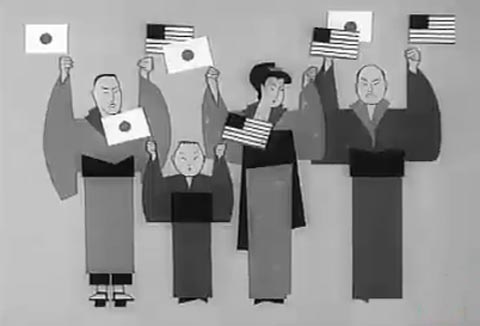
Japan, earthquakes and animation from 1945: “A Few Quick Facts: Japan” was produced by UPA for the Army-Navy Screen Magazine.
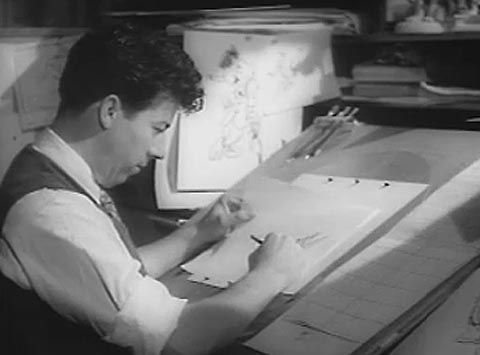
Animator Fred Moore working at his desk (or at least pretending to work). Over one minute of Freddie footage from 1943. Does any other footage of Moore animating exist?
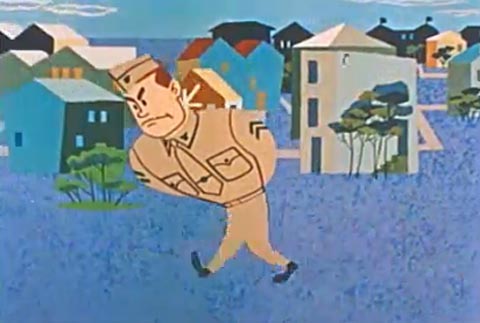
A clip from a 1958 military film produced by New York studio Film Graphics Inc, which was co-owned by Lee Blair (Mary Blair’s husband).
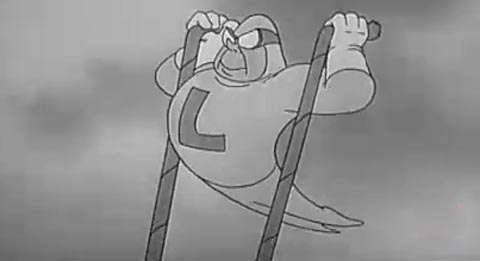
Footage of animators working in the FMPU (First Motion Picture Unit), plus a clip from a FMPU training film. I see Joe Smith and Gus Arriola in this clip, as well as the back of Rudy Larriva and Jules Engel’s heads (I think).
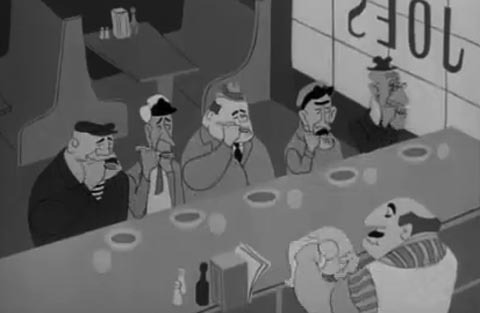
Disorientation Crashes, a handsome UPA short produced for the US Navy’s “Flight Safety” series. Most likely designed by Bill Hurtz and animated by Bobe Cannon and Willis Pyle.
Cartoon Brew: Leading the Animation Conversation |
Permalink |
No comment |
Post tags: First Motion Picture Unit, FMPU, Fred Moore, Freddie Moore, Lee Blair, UPA
Blog: Cartoon Brew (Login to Add to MyJacketFlap)
JacketFlap tags: UPA, Mr. Magoo, Classic, Add a tag
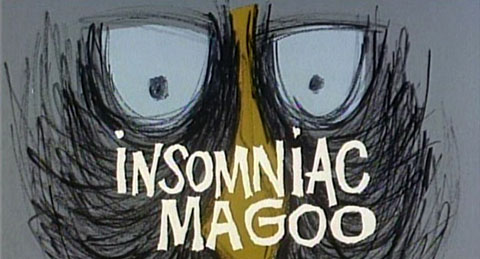
To support the second printing of his self-published book on the making of Mr. Magoo’s Christmas Carol, Darrell Van Citters has begun a blog. It will be updated at least weekly, probably more, and will include info that wouldn’t fit in the book, trivia, info on ancillary Magoo material (like the upcoming Blu-Ray DVD) and more in-depth profiles of UPA crew members. You can also pre-order the second edition of the book through the blog or the website. If you haven’t already done so, I highly recommend this superb volume.
First up at the blog, Darrell discusses the career of Phil Norman, the unsung title card artist and lettering genius of UPA in the early 1960s. (That’s one of his creepiest, above) Bookmark this and visit it regularly.
Add a CommentBlog: Cartoon Brew (Login to Add to MyJacketFlap)
JacketFlap tags: Bob McIntosh, Mister Magoo, UPA, Disney, Animators, RIP, Bambi, Add a tag

Bob McIntosh passed away on June 17, 2010 at the age of 94. Born on March 11, 1916 in Vallejo, California, and raised in Stockton, Bob discovered painting at an early age. Encouraged by Harry Noyes Pratt, the director of Stockton’s then-newly opened Haggin Museum, and mentored by local painter Arthur Haddock, McIntosh applied for a scholarship to Art Center in Los Angeles. He moved with his family to LA in 1934 to attend the school, and afterwards was hired at Disney where he worked on a number of the studio’s features, including Bambi for which he painted multiplane backgrounds directly onto glass. He was drafted into the First Motion Picture Unit during WWII. Following the war, he joined Paul J. Fennell’s commercial studio Cartoon Films Ltd. where he worked on contemporary looking commercials (along with designer Ed Benedict) that prefigured the move towards cartoon modernism in the 1950s.
He joined UPA in the early-1950s and stayed there for the entire decade, primarily painting backgrounds for the Mister Magoo series. This is what I wrote about his work in Cartoon Modern: “McIntosh worked in perhaps the most simplified style of any of the UPA background painters. His ‘poster style’ background paintings used minimal rendering techniques and clean geometric shapes, recalling the work of artists like Stuart Davis and Fernand Léger.” After UPA, Bob painted backgrounds on The Alvin Show and The Lone Ranger at Format Films, George of the Jungle for Jay Ward Productions, and Chuck Jones’s The Phantom Tollbooth, among other projects, before retiring in the early-1980s.
It was a pleasure to get to know Bob while I was writing Cartoon Modern and I kept in touch with him over the last few years of his life. Bob had an admirably unwavering commitment to painting. Though his career in animation stretched over forty years, animation wasn’t his primary passion; it was painting that excited him, and animation provided a steady income allowing him to do what he loved best. He had exhibited his personal artwork since the 1940s, and his lifelong passion for painting resulted in hundreds of canvases in almost every single imaginable style. In his final years, when painting became difficult, he continued to create painted collage canvases. A wonderful life-spanning selection of his paintings can be seen at the Trigg Ison gallery website which represents his work.
Bob was an intensely private person. He never initiated contact; I always had to call him. But when I did call, he was always gracious and friendly. The half dozen or so times I visited him at his home where memorable experiences as he would speak for hours about painting and his life. Our conversations would inevitably shift back to his latest painting projects or his personal theories on painting and color. He was ever the gentleman, even in his advanced years, and dressed with class. He had a good sense of humor about himself and the world around him; whenever I asked him about events that had happened in the past, he enjoyed making jokes about his age by saying, “I think that happened in 1939…or was that 1839?” He would laugh heartily when he recalled the last name of one of his instructors at Art Center: Stan Reckless. He once showed me a collection of unused toilet paper he had gathered during a trip to Europe in the 1940s; the shortage of paper in postwar Europe gave their toilet paper a quality similar to wax paper, which had amused Bob.
Bob is one of the unsung heroes of animation; an artist who worked in the background (and on the backgrounds) while quietly raising the standards of the art form with his masterful artistry. It was a delight and an honor having known him for the short time that I did. His wife, Helen Ner
Add a Comment


